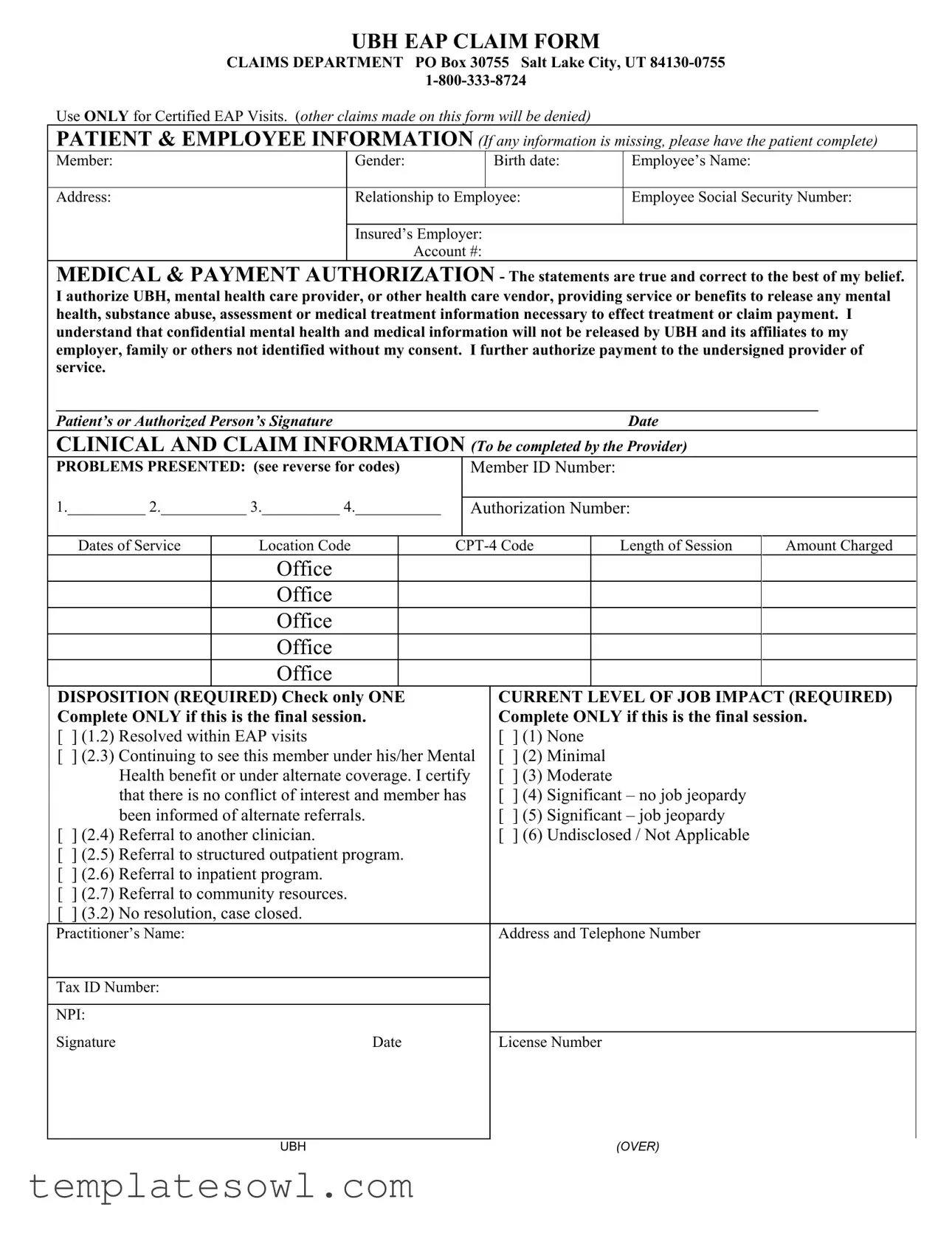
UBH EAP CLAIM FORM
CLAIMS DEPARTMENT PO Box 30755 Salt Lake City, UT 84130-0755
1-800-333-8724
Use ONLY for Certified EAP Visits. (other claims made on this form will be denied)
PATIENT & EMPLOYEE INFORMATION (If any information is missing, please have the patient complete)
Member: |
Gender: |
Birth date: |
Employee’s Name: |
|
|
|
|
Address: |
Relationship to Employee: |
Employee Social Security Number: |
|
|
|
|
Insured’s Employer:
Account #:
MEDICAL & PAYMENT AUTHORIZATION - The statements are true and correct to the best of my belief. I authorize UBH, mental health care provider, or other health care vendor, providing service or benefits to release any mental health, substance abuse, assessment or medical treatment information necessary to effect treatment or claim payment. I understand that confidential mental health and medical information will not be released by UBH and its affiliates to my employer, family or others not identified without my consent. I further authorize payment to the undersigned provider of service.
__________________________________________________________________________________________________
Patient’s or Authorized Person’s SignatureDate
CLINICAL AND CLAIM INFORMATION (To be completed by the Provider)
PROBLEMS PRESENTED: (see reverse for codes) |
Member ID Number: |
1.__________ 2.___________ 3.__________ 4.___________
Dates of Service |
Location Code |
CPT-4 Code |
Length of Session |
Amount Charged |
Office
Office
Office
Office
Office
DISPOSITION (REQUIRED) Check only ONE Complete ONLY if this is the final session.
[ ] (1.2) Resolved within EAP visits
[] (2.3) Continuing to see this member under his/her Mental Health benefit or under alternate coverage. I certify that there is no conflict of interest and member has been informed of alternate referrals.
[ ] (2.4) Referral to another clinician.
[] (2.5) Referral to structured outpatient program.
[] (2.6) Referral to inpatient program.
[] (2.7) Referral to community resources.
[] (3.2) No resolution, case closed.
CURRENT LEVEL OF JOB IMPACT (REQUIRED) Complete ONLY if this is the final session.
[ ] (1) None
[] (2) Minimal
[] (3) Moderate
[] (4) Significant – no job jeopardy
[] (5) Significant – job jeopardy
[] (6) Undisclosed / Not Applicable
Practitioner’s Name:
Tax ID Number:
NPI:
Address and Telephone Number
License Number
WARNING: Any person who knowingly files a statement of claim containing any misrepresentations or any false, incomplete or misleading information may be guilty of a criminal act punishable under law and may be subject to civil penalties.
Alaska Residents: A person who knowingly and with intent to injure, defraud, or deceive an insurance company files a claim containing false, incomplete, or misleading information may be prosecuted under state law.
Arizona Residents: For your protection Arizona law requires the following statement to appear on this form. Any person who knowingly presents a false or fraudulent claim for payment of a loss is subject to criminal and civil penalties.
Arkansas Residents: Any person who knowingly presents a false or fraudulent claim for payment of a loss or benefit or knowingly presents false information in an application for insurance is guilty of a crime and may be subject to fines and confinement in prison.
California Residents: For your protection California law requires the following to appear on this form: Any person who knowingly presents a false or fraudulent claim for the payment of a loss is guilty of a crime and may be subject to fines and confinement in state prison.
Colorado Residents: It is unlawful to knowingly provide false, incomplete, or misleading facts or information to an insurance company for the purpose of defrauding or attempting to defraud the company. Penalties may include imprisonment, fines, denial of insurance, and civil damages. Any insurance company or agent of an insurance company who knowingly provides false, incomplete, or misleading facts or information to a policyholder or claimant for the purpose of defrauding or attempting to defraud the policyholder or claimant with regard to a settlement or award payable from insurance proceeds shall be reported to the Colorado Division of Insurance within the department of regulatory agencies.
Delaware Residents: Any person who knowingly, and with intent to injure, defraud or deceive any insurer, files a statement of claim containing any false, incomplete or misleading information is guilty of a felony. District of Columbia Residents: WARNING: It is a crime to provide false or misleading information to an insurer for the purpose of defrauding the insurer or any other person. Penalties include imprisonment and/or fines. In addition, an insurer may deny insurance benefits if false information materially related to a claim was provided by the applicant.
Florida Residents: Any person who knowingly and with intent to injure, defraud, or deceive any insurer files a statement of claim or an application containing any false, incomplete, or misleading information is guilty of a felony of the third degree.
Hawaii Residents: For your protection, Hawaii law requires you to be informed that presenting a fraudulent claim for payment of a loss or benefit is a crime punishable by fines or imprisonment, or both.
Idaho Residents: Any person who knowingly, and with intent to defraud or deceive any insurance company, files a statement of claim containing any false, incomplete, or misleading information is guilty of a felony. Indiana Residents: A person who knowingly and with intent to defraud an insurer files a statement of claim containing any false, incomplete, or misleading information commits a felony.
Kentucky Residents: Any person who knowingly, and with intent to defraud any insurance company or other person files an application for insurance or a statement of claim containing any materially false information or conceals, for the purpose of misleading, information concerning any fact material thereto commits a fraudulent insurance act, which is a crime.
Louisiana Residents: Any person who knowingly presents a false or fraudulent claim for payment of a loss or benefit or knowingly presents false information in an application for insurance is guilty of a crime and may be subject to fines and confinement in prison.
Maine Residents: It is a crime to knowingly provide false, incomplete or misleading information to an insurance company for the purpose of defrauding the company. Penalties may include imprisonment, fines or a denial of insurance benefits.
Maryland Residents: Any person who knowingly and willfully presents a false or fraudulent claim for payment of a loss or benefit or who knowingly and willfully presents false information in an application for insurance is guilty of a crime and may be subject to fines and confinement in prison.
Minnesota Residents: A person who files a claim with intent to defraud or helps commit a fraud against an insurer is guilty of a crime.
Nevada Residents: Any person who knowingly files a statement of claim containing any misrepresentation or any false, incomplete or misleading information may be guilty of a criminal act punishable under state or federal law, or both, and may be subject to civil penalties.
New Hampshire Residents: Any person who, with a purpose to injure, defraud or deceive any insurance company, files a statement of claim containing any false, incomplete or misleading information is subject to prosecution and punishment for insurance fraud, as provided in RSA 638:20.
New Jersey Residents: Any person who knowingly files a statement of claim containing any false or misleading information is subject to criminal and civil penalties.
New Mexico Residents: Any person who knowingly presents a false or fraudulent claim for payment of a loss or benefit or knowingly presents false information in an application for insurance is guilty of a crime and may be subject to civil fines and criminal penalties.
New York Residents: Any person who knowingly and with intent to defraud any insurance company or other person files an application for insurance or statement of claim containing any materially false information, or conceals for the purpose of misleading, information concerning any material fact, commits a fraudulent insurance act, which is a crime, and shall also be subject to a civil penalty not to exceed $5,000 and the stated value of the claim for each such violation.
Ohio Residents: Any person who, with intent to defraud or knowing that he is facilitating a fraud against an insurer, submits an application or files a claim containing a false or deceptive statement is guilty of insurance fraud.
Oklahoma Residents: WARNING: Any person who knowingly, and with intent to injure, defraud or deceive any insurer, makes any claim for the proceeds of an insurance policy containing any false, incomplete or misleading information is guilty of a felony.
Pennsylvania Residents:
Oregon Residents: Willfully falsifying material facts on an application or claim may subject you to criminal penalties.
Pennsylvania Residents: Any person who knowingly and with intent to defraud any insurance company or other person files an application for insurance or statement of claim containing any materially false information or conceals for the purpose of misleading, information concerning any fact material thereto commits a fraudulent insurance act, which is a crime and subjects such person to criminal and civil penalties.
Tennessee Residents: It is a crime to knowingly provide false, incomplete or misleading information to an insurance company for the purpose of defrauding the company. Penalties include imprisonment, fines and denial of insurance benefits.
Texas Residents: Any person who knowingly presents a false or fraudulent claim for the payment of a loss is guilty of a crime and may be subject to fines and confinement in state prison.
Virginia Residents: It is a crime to knowingly provide false, incomplete or misleading information to an insurance company for the purpose of defrauding the company. Penalties include imprisonment, fines and denial of insurance benefits.
Washington Residents: It is a crime to knowingly provide false, incomplete, or misleading information to an insurance company for the purpose of defrauding the company. Penalties include imprisonment, fines, and denial of insurance benefits.
West Virginia Residents: Any person who knowingly presents a false or fraudulent claim for payment of a loss or benefit or knowingly presents false information in an application for insurance is guilty of a crime and may be subject to fines and confinement in prison.

